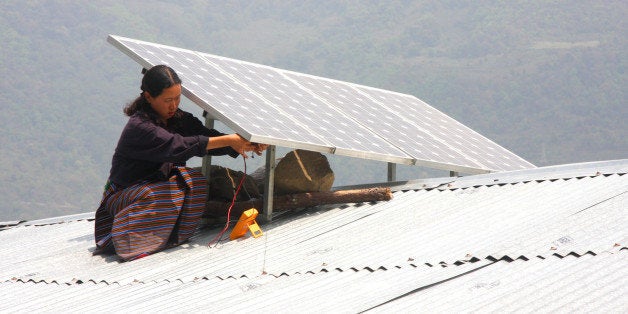
The 2030 Agenda document -- containing the 17 Sustainable Development Goals and 169 targets -- recognizes that climate change is one of the greatest challenges of our time. Its adverse impacts undermine the ability of all countries to achieve sustainable development.
As confirmed by the world's leading scientists, it is no longer a distant or abstract threat. The world's poorest and most vulnerable people are already being impacted by water scarcity, rising sea levels, ocean acidification, loss of agricultural lands and ecosystems, forest fires, floods and intensified extreme events such as hurricanes and typhoons. The annual losses from natural disasters now average U.S. $250 billion to U.S. $300billion. If business as usual continues, half of the world's population could be living in areas of high water stress by 2030 as global temperatures shoot beyond the agreed goal of below 2-degrees Celsius (above pre-industrial levels). Governments have already agreed that drastic cuts in greenhouse-gas emissions are needed to tackle the 40 percent increase in global emissions since 1990 if we are to avoid the devastation that would result from a 4-degree Celsius world.
Despite the multiple risks and linkages with development, inclusion of a stand-alone goal on climate change proved controversial. Some had argued that climate change should be mainstreamed into the other goals. Others that climate change need not be included in the SDGs at all because the UN Framework Convention on Climate Change (UNFCCC) already provides a global framework for action and negotiations on a new universal agreement are due for adoption in December 2015 at the Paris Climate Change summit (known as COP 21). A further complication on the scope of a climate SDG was the parallel negotiations on disaster preparedness and response under the now agreed Sendai Framework for Action on Disaster Risk Reduction. In the end, governments agreed that leaving out climate change would imbalance the SDGs and that response to climate change needs to be taken by every institution on Earth.
The final inclusion of Goal 13 specifying the need to "take urgent action to combat climate change and its impacts" reflects a welcome and important compromise. And one that over time will help to catalyze action on climate change across all international processes and scales, including buttressing results under other SDGs, such as Goal 7 (ensuring access to affordable, reliable, sustainable and modern energy for all).
Due to the expectations for Paris, the climate targets relating to Goal 13 are less specific than those set out under other SDGs. Apart from reiterating the commitment of developed countries to mobilize $100bn by 2020, the targets include strengthening resilience and adaptive capacity to climate-related impacts and natural disasters and integrating climate-change measures into national policies, strategies and planning. These are important hooks. Too few countries have achieved integration of climate change into economic and development planning in a sustained way -- as evidenced by the fact that many countries are struggling to table their first nationally determined plans to cut emissions and adapt to climate impacts in time for Paris. Likewise, Target 13.3, to improve education, awareness-raising and human and institutional capacity on climate-change mitigation, adaptation, impact reduction and early warning, may seem vague but it provides welcome recognition that we all need to work harder to promote deeper understanding of how climate change acts as a stress multiplier that could undermine food, energy and national security. If decision-makers in economic, finance and defense ministries begin to understand the benefits of timely climate action, and the costs of delays and inaction, especially on the vulnerable countries such as Small Island Developing States, least-developed countries and vulnerable groups such as women, youth and marginalized communities, then targets 13.3 and 13(b) will have proved their worth.
One numerical target which is missing from the SDGs is the long-term goal of phasing out greenhouse-gas emissions by mid-century. The work of the Intergovernmental Panel on Climate Change and the UN Environment Programme is making it very clear that staying below the global temperature goal of 2-degrees Celsius will require drastic cuts in global emissions to achieve carbon neutrality in the second half of the century. An increasing number of development bodies including the World Bank are recognizing that achieving zero poverty will have to go hand in hand with getting to low- or near-zero emissions. Fortunately, more and more countries are advocating the inclusion of a long-term goal specifying carbon neutrality or decarbonization of the world economy in the second half of the century as evidenced by the recent adoption of this goal by the G7 at their summit in Germany. An increasing number of investors, companies and cities are also committing to cutting emissions by 80-100 percent by 2050 and switching to 100 percent renewable energy. A global goal to decarbonize the world economy could complement Goal 13 and give a clear steer to investors, business and citizens that the only future that is safe, clean and prosperous is a future based on zero emissions, zero poverty and 100 percent access to clean energy for all.
This post is part of a series produced by The Huffington Post, "What's Working: Sustainable Development Goals," in conjunction with the United Nations' Sustainable Development Goals (SDGs). The proposed set of milestones will be the subject of discussion at the UN General Assembly meeting on Sept. 25-27, 2015 in New York. The goals, which will replace the UN's Millennium Development Goals (2000-2015), cover 17 key areas of development -- including poverty, hunger, health, education, and gender equality, among many others. As part of The Huffington Post's commitment to solutions-oriented journalism, this What's Working SDG blog series will focus on one goal every weekday in September. This post addresses Goal 13.